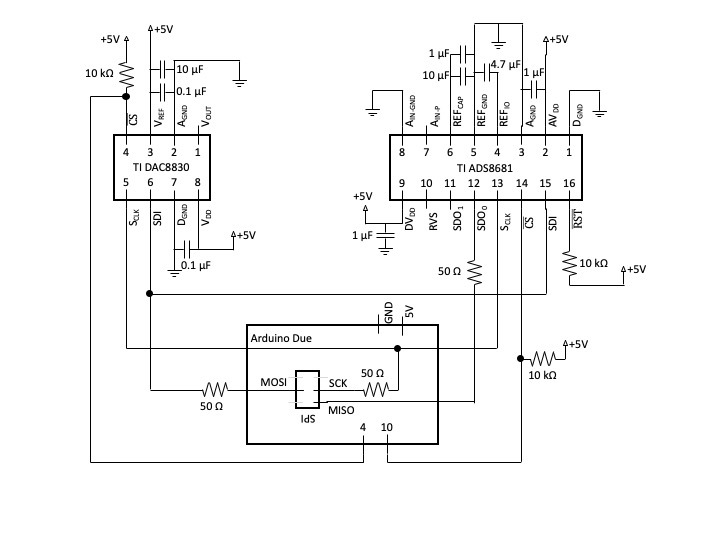Other Parts Discussed in Thread: DAC8830
I am trying to work with the ADS8681 through the SPI interface of an Arduino Due, so that I can obtain 16-bit A/D resolution on the Due. However, I have run into big problems. I don't get accurate readings from the ADS8681, and furthermore, it disrupts the function of other SPI devices.
I followed the datasheet as accurately as I could (Figs. 53, 71), and confirmed my understanding using the ADS8681EVM-PDK circuit diagram (Fig. 21). The SPI interface on the Due uses 3.3V logic, and I'm using the 5V power from the Due as AVDD and DVDD for the ADS8681. I left pins 10 (RVS) and 11 (SDO-1) floating, and 9 (RST) tied high. There are 50-Ohm resistors on the SPI lines.
I monitored the SPI outputs from the Due with an oscilloscope, and when the ADS8681 is disconnected, all act as expected. That is, when chip select (CS) goes low, MOSI also goes low (which I understand to be the read command), and SCK has sixteen 3.3V pulses. However, when I connect the ADS8681, the voltage measured at the SCLK pin has a 100 mV offset, and each peak pulse is <1 V. On Due side of the 50-Ohm resistor, SCK has an offset (500 mV), which goes to 0 when CS goes low, and the clock peaks remain 3.3V. This makes me think the S_CLK pin on the ADS8681 is a low resistance path to ground, which is strange. This does not appear to be a power supply problem: ground and 5V remain stable. Also, SDI (pin 15) on the ADS8681 appears to be always floating, which I guess is "tristate".
I'm also using the TI DAC8830 to obtain 16-bit D/A resolution. That device works fine with the Due when only it is connected to the SPI. I can specify what output I want, and it does it. When the ADS8681 is connected, the DAC8830 stops working, likely because the SPI outputs fall below TTL.
I would be grateful for help figuring out what is wrong. Right now my theories are maybe that the chip is fried, or the breakout board I soldered it to is adding some fatal stray capacitance or something. I tried a second chip, soldered by better hands than mine, but it has the same problem. Thanks in advance,
-Matthew

